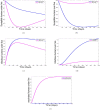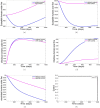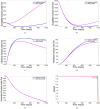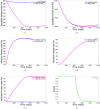Optimal control of a two-group malaria transmission model with vaccination
- PMID: 36575768
- PMCID: PMC9780107
- DOI: 10.1007/s13721-022-00403-0
Optimal control of a two-group malaria transmission model with vaccination
Abstract
Malaria is a vector-borne disease that poses major health challenges globally, with the highest burden in children less than 5 years old. Prevention and treatment have been the main interventions measures until the recent groundbreaking highly recommended malaria vaccine by WHO for children below five. A two-group malaria model structured by age with vaccination of individuals aged below 5 years old is formulated and theoretically analyzed. The disease-free equilibrium is globally asymptotically stable when the disease-induced death rate in both human groups is zero. Descarte's rule of signs is used to discuss the possible existence of multiple endemic equilibria. By construction, mathematical models inherit the loss of information that could make prediction of model outcomes imprecise. Thus, a global sensitivity analysis of the basic reproduction number and the vaccination class as response functions using Latin-Hypercube Sampling in combination with partial rank correlation coefficient are graphically depicted. As expected, the most sensitive parameters are related to children under 5 years old. Through the application of optimal control theory, the best combination of interventions measures to mitigate the spread of malaria is investigated. Simulations results show that concurrently applying the three intervention measures, namely: personal protection, treatment, and vaccination of childreen under-five is the best strategy for fighting against malaria epidemic in a community, relative to using either single or any dual combination of intervention(s) at a time.
Keywords: Malaria; Optimal control; Sensitivity analysis; Vaccination.
© The Author(s), under exclusive licence to Springer-Verlag GmbH Austria, part of Springer Nature 2022, Springer Nature or its licensor (e.g. a society or other partner) holds exclusive rights to this article under a publishing agreement with the author(s) or other rightsholder(s); author self-archiving of the accepted manuscript version of this article is solely governed by the terms of such publishing agreement and applicable law.
Conflict of interest statement
Conflict of InterestNone.
Figures









Similar articles
-
A Mathematical Model of COVID-19 with Vaccination and Treatment.Comput Math Methods Med. 2021 Sep 4;2021:1250129. doi: 10.1155/2021/1250129. eCollection 2021. Comput Math Methods Med. 2021. PMID: 34497662 Free PMC article.
-
Assessing the Impact of Relapse, Reinfection and Recrudescence on Malaria Eradication Policy: A Bifurcation and Optimal Control Analysis.Trop Med Infect Dis. 2022 Sep 24;7(10):263. doi: 10.3390/tropicalmed7100263. Trop Med Infect Dis. 2022. PMID: 36288004 Free PMC article.
-
Malaria and COVID-19 co-dynamics: A mathematical model and optimal control.Appl Math Model. 2021 Nov;99:294-327. doi: 10.1016/j.apm.2021.06.016. Epub 2021 Jul 2. Appl Math Model. 2021. PMID: 34230748 Free PMC article.
-
Tuberculosis.In: Holmes KK, Bertozzi S, Bloom BR, Jha P, editors. Major Infectious Diseases. 3rd edition. Washington (DC): The International Bank for Reconstruction and Development / The World Bank; 2017 Nov 3. Chapter 11. In: Holmes KK, Bertozzi S, Bloom BR, Jha P, editors. Major Infectious Diseases. 3rd edition. Washington (DC): The International Bank for Reconstruction and Development / The World Bank; 2017 Nov 3. Chapter 11. PMID: 30212088 Free Books & Documents. Review.
-
Conquering the intolerable burden of malaria: what's new, what's needed: a summary.Am J Trop Med Hyg. 2004 Aug;71(2 Suppl):1-15. Am J Trop Med Hyg. 2004. PMID: 15331814 Review.
References
-
- Agusto FB, Gumel AB, Parham PE. Qualitative assessment of the role of temperature variations on malaria transmission dynamics. J Biol Syst. 2015;23(04):1550030. doi: 10.1142/S0218339015500308. - DOI
-
- Bala S, Gimba B. Global sensitivity analysis to study the impacts of bed-nets, drug treatment, and their efficacies on a two-strain malaria model. Math Comput Appl. 2019;24(1):32.
-
- Bauer AL, Hogue IB, Marino S, Kirschner DE. The effects of hiv-1 infection on latent tuberculosis. Math Model Nat Phenomena. 2008;3(7):229–266. doi: 10.1051/mmnp:2008051. - DOI
-
- Bernoulli D (1760) Essai d’une nouvelle analyse de la mortalité causée par la petite vérole, et des avantages de l’inoculation pour la prévenir. Histoire de l’Acad Roy Sci (Paris) avec Mem, pages 1–45
LinkOut - more resources
Full Text Sources
Research Materials
